
by Mary Cirillo
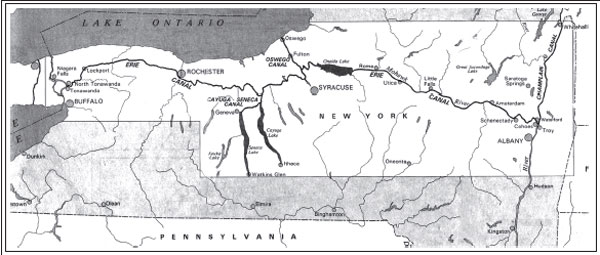
The idea of the Erie Canal was to expand on the passage
that God had already started and expected people to
finish. Before the canal, the only way that people and
goods could move to the West was by following the Hudson
River and then connecting to the Mohawk River. The problem
was that the Mohawk River did not connect all the way to the
Great Lakes and, therefore, cut off any commerce past the
western-most point on the water. When completed, the canal
would be able to go right through to Lake Erie, connecting the
East to the West. In connecting the East and West, backers of
the canal hoped that increased commerce would revolutionize
our society and bring many positive changes to it. The Erie
Canal proved to be one of the major turning points in New
York State and American history. The increase in commerce
and growing of communities led New York on the path to
becoming the Empire State. [Sheriff, 1996]
The newly formed United States of America was not
anywhere close to its present size. In order for real expansion to
occur, an easy to navigate east-west route was needed. It took
the devotion of New York Governor DeWitt Clinton to convince
the politicians that it was indeed worth the debt to build the
artificial river, nicknamed “Clinton’s Ditch.” DeWitt Clinton
lobbied for the idea of The Erie Canal. He argued that the canal
would bring commerce to the wilderness of New York State and
New York City. His vision would prove to be accurate.
[Sheriff, 1996]
The route that the canal would follow was the only
good east-west passage available along the East Coast,
between the Catskill Mountains and the Adirondack Mountains.
The lower section of this waterway would follow the
Hudson River from Troy south to New York Bay, past
| Page 24 | 3rd Quarter 2010 |
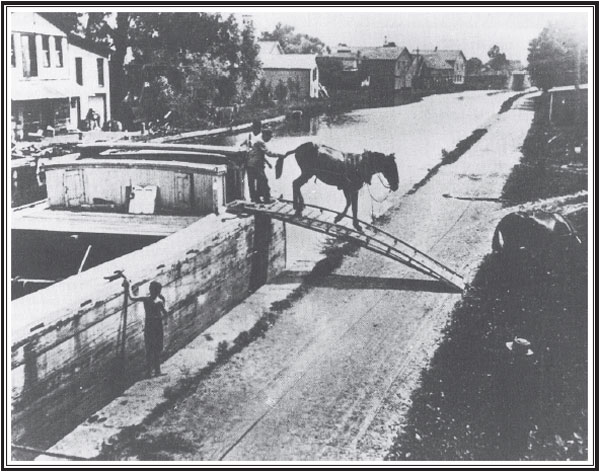
Manhattan in New York City, and on to the Atlantic Ocean.
[Rosenberg, no date] From Troy, the Erie Canal would then
run west along the Mohawk River to Rome, and then on
through to Syracuse, Rochester, Buffalo, and Lake Erie. This
would open a passage from the Atlantic Ocean all the way west
to the Great Lakes, giving travelers an easier way to get around
the Appalachian Mountains. This allowed the country to
expand and for industry to develop in New York State. The
commerce that the canal brought to the state was more than
anyone could imagine. With the tolls it collected, it paid off all
of its debt of seven million dollars (Time Line, no date) in just
over a decade in 1837. [Bernstein, 2005]
The commerce allowed newly formed cities to develop
along the new passage. With the growth of these communities
came new customers for the goods being shipped up from New
York City. The canal would open up the West, allowing people
to travel easier than by buggy, horse, or foot. Tons of goods
could be shipped faster, easier, and cheaper. [Sheriff, 1996]
Digging of the canal began near Rome, NY on July 4,
1817, heading east to the Hudson River. The laborers who
constructed the canal were primarily German, British, and Irish
immigrants. [Sheriff, 1996] Farmers, artisans, and merchants
became contractors responsible for building their own small
portions of the canal. [Sheriff, 1996]
The engineering accomplishment of completing the
Erie Canal was even more extraordinary, considering the state of
engineering back then. It may have actually spawned the
profession of civil engineering. According to the President of
the American Society of Civil Engineering, created in 1882,
“Few men have ever accomplished so much with so little
means. The builders of the Erie have built the longest canal, in
the least time, with the least expense, for the least money, and
to the greatest public benefit.” [Hartway, no date]
The total length of the Erie Canal was completed
October 25, 1825. It was 363 miles long, using 86 locks to raise
and lower the boats along 680 feet of elevation from the
Hudson River west. The Erie Canal was 40 feet wide and 4 feet
deep. [Sheriff, 1996]
Freight service could move at about 2 miles per hour.
Packet boats carrying people moved approximately twice as fast
| Page 25 | 3rd Quarter 2010 |
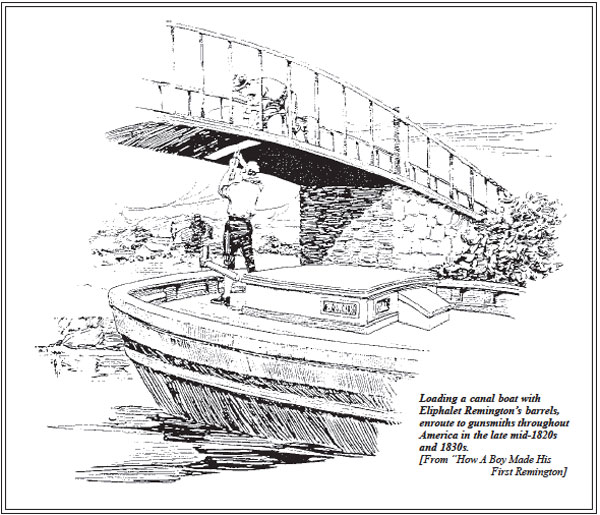
at about 4 miles per hour. Passengers could go from New York
City to Buffalo in about four days. [Sheriff, 1996]
As each section of the Erie Canal opened, commerce
came to that area of the state and it flourished. [Larkin, 1998]
In 1820, five years before the official opening of the Erie Canal,
New York State had already become the most populous state, a
title that Virginia held up to that point in time. [Sheriff, 1996]
In addition, in 1820, the canal counties already made up 38
percent of the state’s population. [Bernstein, 2005]
In the first ten years of the Erie Canal, the population
doubled in five of the lock cities; Albany, Troy, Utica, Syracuse,
and Lockport all grew with the canal. Rochester’s population
tripled and Buffalo’s residents quadrupled. [Larkin, 1998]
New York City and surrounding areas in New Jersey and
Connecticut grew to over a million people, in part due to the
commerce created by all the products that were imported from
other countries and sold to communities located up on the Erie
Canal. Similarly, agricultural goods traveling from areas such as
Rochester and other communities along the canal to the port
city helped New York City become the greatest seaport for that
reason.[Sheriff, 1996]
In 1825, the first year that the completed canal was
open, the total amount of goods being moved east bound was
185,000 tons, which included “562,000 bushels of wheat,
221,000 barrels of flour, 435,000 gallons of spirits, and 32 million
board feet of lumber.” [Larkin, 1998] Genesee flour was the
largest good transported east on the canal. [Bernstein, 2005]
The freight that moved westbound on the Erie Canal
totaled 32,0000 tons of imported and domestic goods. Qnce the
canal was open, a boat could move a ton of wheat for five
dollars from Buffalo to New York City, compared to 100 dollars
by horse-drawn wagon. By transporting it by coach, it cost a
person in Albany $ 2.15 and it took 20 days to get there.
[Larkin, 1998] The canal earned great revenue for the State
of New York. In 1824, the canal brought in $300,000 from tolls.
[Larkin, 1998]
| Page 26 | 3rd Quarter 2010 |
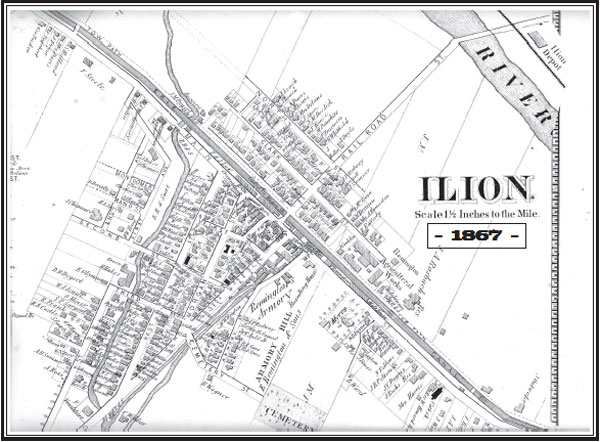
The canal truly helped New York become the Empire
State. [Sheriff, 1996] Walter D. Edmonds’ sums up exactly
what the canal did for the country in his book, Rome Haul. He
stated, “A swarming hive. Boats coming and going … Freight
going west and raw food east. .. people going west. .. people
coming east. But the canawlers keep a-moving. By grab, it’s
the bowels of the nation! It’s the whole shebang of life.”
[Larkin, 1998]
Little Falls, New York was one of the cities that grew
rapidly with the Erie Canal. In the local newspaper, People’s
Friend, of the time, it lists how many boats had gone by in the
month of May in 1825. It states that it averaged fifty boats per
day. For the whole month of May, Little Falls had seen 1,550
boats, not counting the rafts. Most of the boats were filled with
“riches from the west: but the grand staple of that quarter is
flour; while passengers, and merchandize of various
kinds, constitute the principal freight of those from the east.”
[Canal, 1826]
Not only were goods moved on the Erie Canal, but
people were traveling on it as well. People could travel much
easier and without so much of a financial burden. Packet boats
brought people on any given length of the canal. Niagara Falls
became a big attraction after the canal opened. It was a new
wonder of the world that the population barely knew about.
This attraction could not be easily reached before. [Sheriff,
1996]
The amount of money collected in tolls in a given year
gives proof that many people traveled on the canal. In the old
Little Falls People’s Friend newspaper, it gives the total of each
lock tolls from the Erie Canal and the Champlain Canal in the
year 1827. They show the total amount is $859,058 and in 1826
is $762,003. That is a difference of $97,054. This is an example of
the growth of the canal in just a year when it had just officially
opened two years earlier in 1825. [Canal Toll, 1828] It also
has each city’s total. The city with the highest total was
Albany. The one with the lowest amount was Black Rock.
[Canal Toll, 1828]
Nobody estimated the success of the canal and, in
1835, the commissioners and politicians started talking about an
expansion project. The Erie Canal would be expanded to seven
feet deep and 70 feet wide, allowing more cargo and passengers
to travel on the bustling canal. It took longer to complete the
expansion than the original canal because they were building
during the time of the Civil War. [Larkin, 1998]
In the middle 1800s, between the development of the
railroads and the Delaware and Hudson Canal, the traffic on the
| Page 27 | 3rd Quarter 2010 |
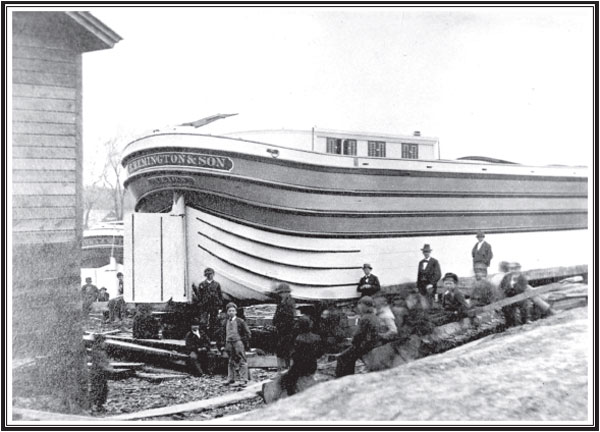
The canal boat “E. REMINGTON & SON” in drydock – circa 1850s.
Unfortunately, nothing else is known about this remarkable boat. Note that it was made before Eliphalet’s son, Samuel, joined the company in 1856.
Remington Archives Photograph Collection – Ilion, New York
Erie and Barge Canal slowly decreased. Even while the rest of
the country was expanding, the 1850 population of the canal
counties was down 28 percent. In the rest of the country and
state, the population was doubling. Many people started to
move West where they had fresh land to farm and to find a
better life than that by the canal. Soon, the railroads came to
many more cities, allowing the people out West to be connected
with the East without going through the Great Lakes
and down the Erie Canal. Not only did the canal have the
eventual effect of decreasing the population of the counties
along the canal, it had a similar effect on the populations of
Vermont and New Hampshire. [Bernstein, 2005]
The Erie Canal Today
In recent years, there has been a new wave of support
for the historic Erie Canal. Supporters are trying to convince
people in New York City to visit the canal by putting in a Canal
Interpretive Center at Battery Park in Manhattan. Of course, the
people trying to revive the actual Erie Canal are not happy that
the Erie Canal Officials want to build the center in New York
City. [Promoting Erie Canal, 2004] Each of the old canal
towns is trying to revive business and tourism by updating
their cities, waterfronts, and canal ports. Many canal towns
offer boat tours and canal museums. They want to improve
recreational travel on the canal and attract canal tourists into
their towns’ businesses and attractions. [Williams, 1997] For
example, Little Falls has tried to clean up its downtown and
develop Moss Island. They have shops and eateries right next
to the canal underneath the Route 167 Bridge. Each summer,
they hold the Canal Days, hoping that more people will get
interested in the canal. [Herkimer at 200, 1992]
Grants and low interest loans are being used by towns
to bring back the times of the canal. Former Secretary of
Housing and Urban Development, Andrew M. Cuomo stated,
“Once they move out of manufacturing, what do they do? The
answer for the nation has been tourism. San Antonio did it
with the Riverwalk, Washington State did it with the Puget
Sound, and Baltimore did it with the Inner Harbor. Frankly,
the Erie Canal has nicer geography and a richer history.”
[Williams, 1997]
| Page 28 | 3rd Quarter 2010 |

Canal boats came in many sizes and shapes in the 1800s. Teams of mules or horses pulled the boat along at a walking pace.
Bremer photograph – Ilion Free Public Library collection
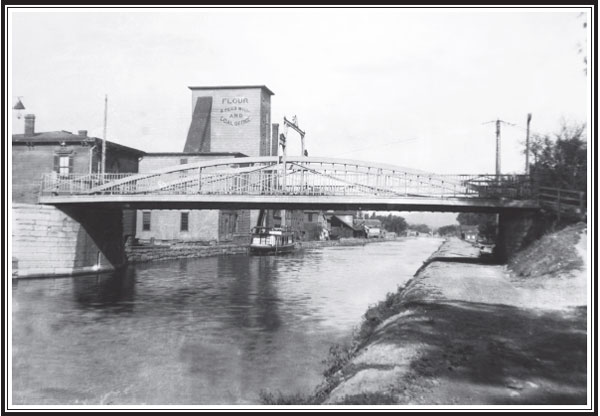
The original canal was widened several times over the years. This photograph of the canal passing
through Ilion dates from the early 1900s.
Ilion Free Public Library collection
| Page 29 | 3rd Quarter 2010 |
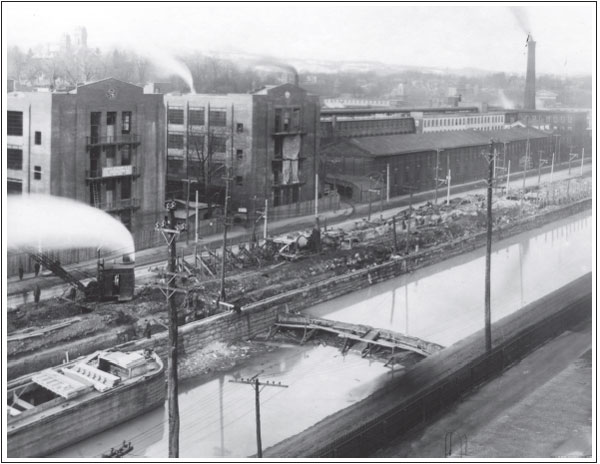
Construction of the Remington factory in Ilion,New York in 1915.Note the Erie Barge Canal on
the property line.
Remington Archives Photo Collection
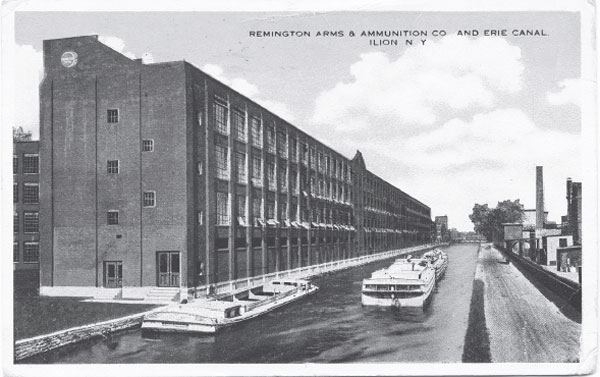
After Remington constructed its new plant in Ilion in 1915, the Erie Barge Canal ran alongside the
northern-most building.
Remington Archives Photo Collection
| Page 30 | 3rd Quarter 2010 |
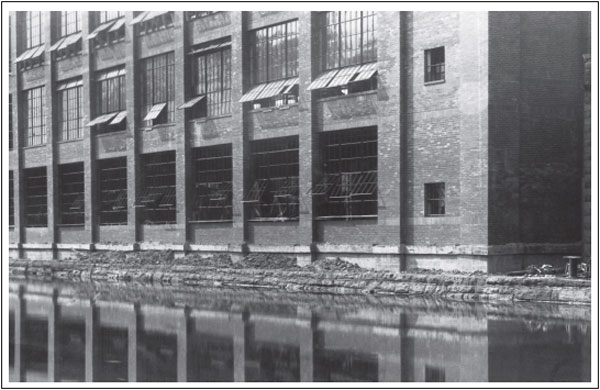
A closeup view of the Erie Barge Canal alongside the Remington factory.
Remington Archives Photo Collection
| Page 31 | 3rd Quarter 2010 |
| On-line Search/Sort Journal Index |
On-line Journal Articles New Journals have links to
|
